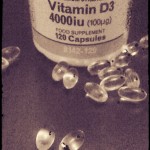 The debate regarding ergocalciferol versus cholecalciferol supplementation is interesting. Supplemental vitamin D is available in two forms, cholecalciferol (vitamin D3) and ergocalciferol (vitamin D2). The dietary cholecalciferol is identical to that produced in the skin by the action of ultra violet B radiation. Ergocalciferol was first produced artificially in the 1920s in a process that was patented, and the synthetic manufacture lead to the development of the medicinal preparations called Viosterol. The form available on prescription is the D2 form, and many dietary supplements also contain vitamin D2. Early studies investigating the effects of vitamin D used ergocalciferol, and were performed on children with rickets over 70 years ago. The validity of the result from this work has been repeatedly questioned in the scientific literature. Since that time evidence has accumulated to suggest that cholecalciferol is more biologically active and should be the preferred option in supplementation.
The debate regarding ergocalciferol versus cholecalciferol supplementation is interesting. Supplemental vitamin D is available in two forms, cholecalciferol (vitamin D3) and ergocalciferol (vitamin D2). The dietary cholecalciferol is identical to that produced in the skin by the action of ultra violet B radiation. Ergocalciferol was first produced artificially in the 1920s in a process that was patented, and the synthetic manufacture lead to the development of the medicinal preparations called Viosterol. The form available on prescription is the D2 form, and many dietary supplements also contain vitamin D2. Early studies investigating the effects of vitamin D used ergocalciferol, and were performed on children with rickets over 70 years ago. The validity of the result from this work has been repeatedly questioned in the scientific literature. Since that time evidence has accumulated to suggest that cholecalciferol is more biologically active and should be the preferred option in supplementation.
Both ergocalciferol and cholecalciferol are not vitamins, but steroid hormones that belong to the same class as testosterone, cholesterol and oestrogen, amongst others. The vitamin D absorbed from the gastrointestinal tract enters the portal blood system where it binds to the vitamin D binding protein (DBP). The cholecalciferol or ergocalciferol is then transported to the liver where they are hydroxylated to form 25-hydroxyvitamin D3 [25(OH)D3] or 25(OH)D2, respectively. The resultant 25(OH)D is then transported to the kidney where it is further hydroxylated to 1,25-dihydroxyvitmain D3 [1,25(OH)2D3] or 1,25(OH)2D2, respectively. This final active form of vitamin D then plays a role in calcium metabolism as well as having important immunomodulatory effects, including important role in the prevention of infection and cancers. The metabolic fate of the vitamin D3 produced in the skin is the same albeit from a different starting location
Evidence suggests that the vitamin D binding protein in the blood has a higher affinity for the cholecalciferol compared to ergocalciferol. Because ergocalciferol binds less strongly, it has a shorter circulating half life and is cleared from the blood more quickly. Research in the American Journal of Clinical Nutrition in 19981 showed that after supplementation of 4000 IU of vitamin D for 2 weeks, a 70 % greater increase in serum 25(OH)D was see with vitamin D3 over that of vitamin D2. Vitamin D3 also appears to have a higher affinity for the enzyme vitamin D hydroxylase, the enzyme responsible for hydroxylating cholecalciferol and ergocalciferol to their active 25-hydroxyvitamin D3 and 25-hydroxyvitamin D2 forms. Results from comparative studies have shown that the hydroxylation of cholecalciferol occurs at a significantly faster rate than that of ergocalciferol.
This half-life of ergocalciferol can be further reduced because it can also be 24-hydroxylated in the liver. This hydroxylation reduces further the ability of vitamin D2 to bind to the vitamin D receptor, thus exacerbating its enhanced clearance from the blood. It is also very likely that ergocalciferol and cholecalciferol share different metabolic fates. Ergocalciferol can be further hydroxylated to 24,25-dihydroxyvitamin D2 [24,25(OH)2D2] and then 1,24,25 trihydroxyvitamin D2 [1,24,25(OH)3D2] which is a non-biologically active form of the molecule. However, vitamin D3 requires a further reaction to deactivate it thus potentiating its biological activity in the body. Some studies have also questioned the stability of vitamin D2 in powder form in dietary supplements. Taken as a whole the balance of evidence suggests that cholecalciferol is more biologically active than ergocalciferol and should be the preferred choice in supplementation.
RdB
